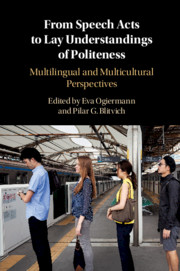Book contents
- From Speech Acts to Lay Understandings of Politeness
- From Speech Acts to Lay Understandings of Politeness
- Copyright page
- Contents
- Figures
- Tables
- Contributors
- Im/politeness between the Analyst and Participant Perspectives: An Overview of the Field
- Part I Concepts and Cultural Norms Underlying Speech Acts
- 1 Offers in Greek Revisited
- 2 Politeness, Praising, and Identity Construction in a Greek Food Blog
- 3 Online Compliments of Iranian Facebook Users
- 4 Qué perfección : Complimenting Behaviour among Ecuadorian Teenage Girls on Instagram
- 5 Not All Positive: On the Landscape of Thanking Items in Cypriot Greek
- 6 Researching Im/politeness in Face-to-Face Interactions: On Disagreements in Polish Homes
- Part II Concepts and Cultural Norms Underlying Politeness
- Epilogue: Personal Encounters with Politeness Research
- Index
- References
3 - Online Compliments of Iranian Facebook Users
from Part I - Concepts and Cultural Norms Underlying Speech Acts
Published online by Cambridge University Press: 14 June 2019
- From Speech Acts to Lay Understandings of Politeness
- From Speech Acts to Lay Understandings of Politeness
- Copyright page
- Contents
- Figures
- Tables
- Contributors
- Im/politeness between the Analyst and Participant Perspectives: An Overview of the Field
- Part I Concepts and Cultural Norms Underlying Speech Acts
- 1 Offers in Greek Revisited
- 2 Politeness, Praising, and Identity Construction in a Greek Food Blog
- 3 Online Compliments of Iranian Facebook Users
- 4 Qué perfección : Complimenting Behaviour among Ecuadorian Teenage Girls on Instagram
- 5 Not All Positive: On the Landscape of Thanking Items in Cypriot Greek
- 6 Researching Im/politeness in Face-to-Face Interactions: On Disagreements in Polish Homes
- Part II Concepts and Cultural Norms Underlying Politeness
- Epilogue: Personal Encounters with Politeness Research
- Index
- References
Summary
Eslami, Jabbari, and Kuo examine over 4,000 compliments produced by Persian Facebook users, focusing on comments on profile pictures and providing a systematic overview of online complimenting behavior in a language that remains strongly underrepresented within politeness research. The authors examine verbal and non-verbal compliment forms, the latter overwhelmingly represented by ‘likes’, a convenient way of paying compliments, though the exact target of the ‘like’ remains ambiguous. The verbal compliments involve different forms of modification and take explicit (often elliptical) and implicit forms. The interpretation of implicit forms requires the complimentee and the analyst to infer implied meaning based on common background knowledge reflecting in-group norms and values, though the presence of the picture and the responses to the compliment facilitate the analyst’s interpretation. The study compares the data to previous (unpublished) work on face-to-face compliments in Persian, and concludes that implicit compliments are more common in the examined online environment, with modification playing a central role in achieving the desired effect of the comment.
Keywords
- Type
- Chapter
- Information
- From Speech Acts to Lay Understandings of PolitenessMultilingual and Multicultural Perspectives, pp. 68 - 92Publisher: Cambridge University PressPrint publication year: 2019
References
- 5
- Cited by



